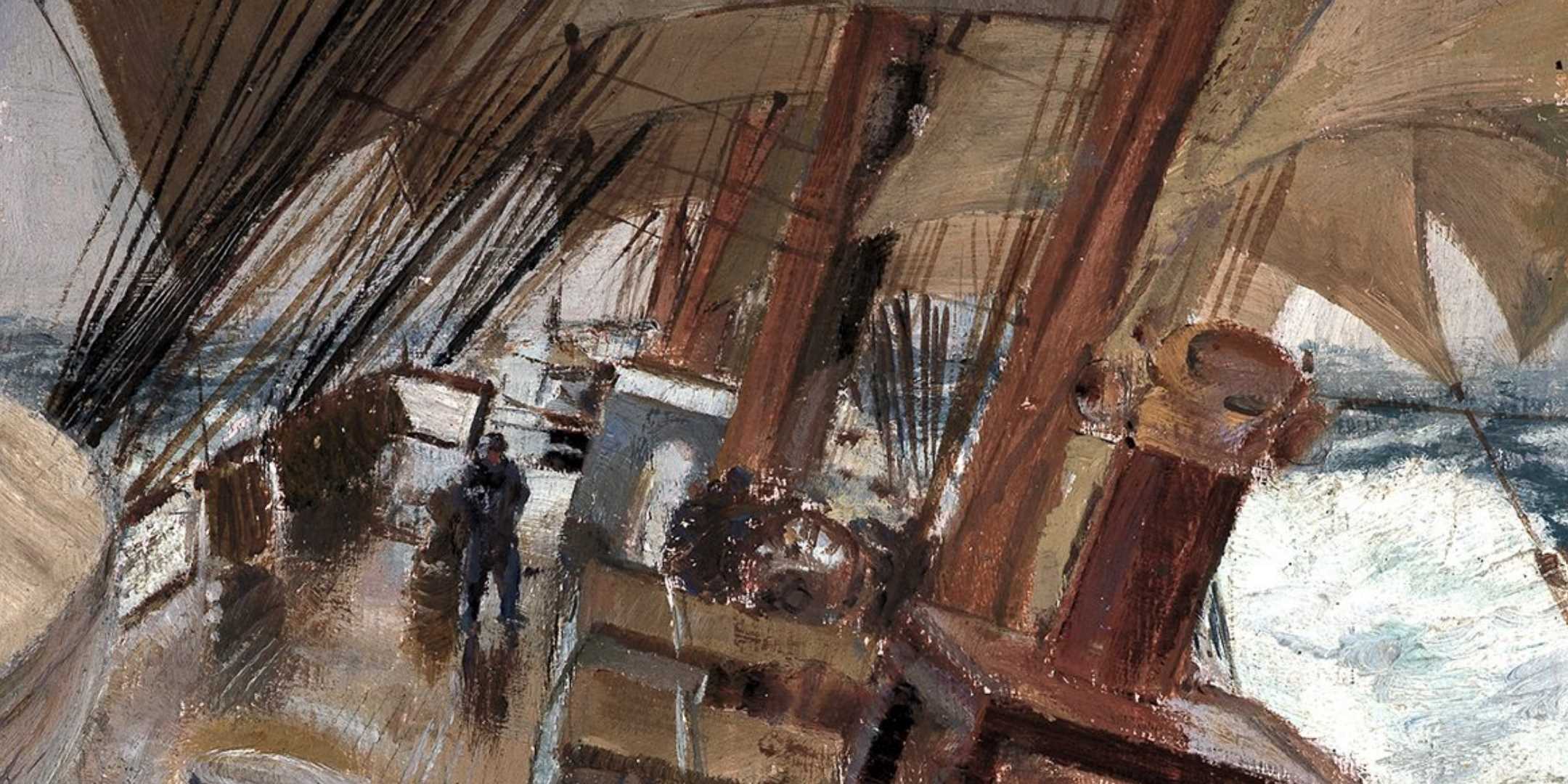
The Last of the Windjammers
The windjammer sailors work is based on a concept by marine artist, sculptor and sailor Dennis Adams (1914-2001), who had sailed on the last of the windjammers.
Dennis Adams at work in his studio in 1998. Image: Andrew Frolows / ANMM.
In 1934, during the economic depression, the 20 year old was living in Sydney working as a commercial artist with artists such as William Dobell and Lloyd Rees. He had studied at the Julian Ashton Art School in Sydney. His father, a marine engineer, had retired from the sea to farm sheep in Queensland when Adams was a boy. Filled with stories of adventure the young Adams yearned for a sailor’s life on the big, four masted ships which were becoming increasingly rare in Australian ports. When they did visit Sydney, Dennis Adams would be there watching those big ships enter the Heads – linking Australia with ‘the rest of the world.’ He determined to go and study art at the Royal Academy in the United Kingdom and so sought a crew position on one of Finnish ship owner Gustaf Erikson’s regular fleet of windjammers which loaded grain for Europe on the Yorke Peninsula of South Australia.
Crew positions were few, with the small crews populated by mixed Finnish, European, and international crews who sailed from Europe to Australian ports. Only if they deserted would one of the ‘Adelaide boys hanging around the ports’ get a berth. With little chance of securing a berth Adams left for South Australia and signed on as an ‘able-bodied passenger’ on the first available ship leaving from Port Victoria. It was Herzogin Cecilie, the majestic four-masted barque the Duchess, the former German Imperial training ship purchased by Erikson from the French, who received it as part of war reparations. What luck, he thought, as the ship slowly dropped its moorings and glided out of the Spencer Gulf in January 1935.
From over the bows on Herzogin Cecilie. ANMM Collection: 00032194.
Unfinished sketch from the Lawhill. ANMM Collection: ANMM Collection: 00032212.
Martin Vaz from Lawhill. ANMM Collection: 00032208.
Dennis Adams sailed to the UK on Herzogin Cecilie to study at the Royal Academy as an able-bodied passenger, returning on Lawhill in 1938.
Paying six shillings a day, ‘expensive’ for Adams, he joined the port watch and lived and worked in their focstle, climbing the rigging with his paintbox in hand, determined to make a pictorial record of life on these last windjammers before they disappeared from the world’s oceans. It was exotic and cosmopolitan and Adams found it magnificent making quick little oil sketches chronicling the crew as they completed the all-important maintenance tasks which kept the ship in operation. Erikson ran his fleet leanly, sailing to Australia under ballast and returning loaded with grain. The cargoes were insured but not the ships so under direction from the Swedish-Finnish officers, the crew spent their days chipping rust, painting, greasing blocks, overhauling rigging and repairing sails sustained by pig blood pancakes, cabbages and a good supply of tinned food. The vessel, furling sail with almost the entire crew on the yards. It was dangerous but thrilling work. The next year the graceful ship foundered on the rocks at Sewer Mill Cove on the south Devon Coast UK and as months passed was damaged irreparably before it could be salvaged.
Tarring down backstays, Herzogin Cecilie. ANMM Collection: 00032200.
Changing sails, Herzogin Cecilie. ANMM Collection: 00032206.
Caulking the deck, Lawhill. ANMM Collection: 00032201.
Adams had arrived in Falmouth in 1935 with his pencil and oil sketches on sail canvas and spent several years studying art at the Royal Arts School, with its emphasis on life drawing and figurative work, skills which combined with his experience under sail were to invest his subsequent work with a muscular force.
Adams returned to Australia early in 1939 on Erikson’s Lawhill, with war clouds gathering. The outbreak of war later that year decimated the number of ships remaining in Erikson’s fleet. One, the Olivebank hit a mine on 8 September 1939, with loss of 14 on board including passengers and officers from Adams’ 1935 voyage who had caught the bug and sailed on.
Adams enlisted as a solider in the 18th Battalion and was later seconded to the Department of Home Security for camouflage work, as did artists such as Frank Hinder, Gervais Purcell and William Dobell. In 1942 he was appointed an official war artist to represent the activities of the Australian and US Navies and the merchant marine in the South Pacific. He was made Captain in Military History Section AIF in 1943. He served in New Guinea, Middle East, Italy, Egypt, UK, France, Belgium, Newfoundland, Canada, the Bahamas, USA, and Japan.
After WWII Dennis Adams established a career as an artist specialising mainly in maritime and war art and also taught art at the East Sydney Technical College. He completed numerous public works of art, mostly in bronze including the Second World War Servicewomen’s Memorial 1990, the Royal Australian Regiment Memorial, 1976 in Sydney, and paintings and sculptures at the Australian War Memorial in Canberra, including Survivors 1968-73, a bronze and concrete memorial to merchant seamen, and Ship bearing red ten, 1967, a quiet intense red cedar work based on an officer at watch in the collection. In 1989, he was awarded the order of Australia Medal. He died in 2001.
Footage taken on board Herzogin Cecilie 1932. Dennis Adams sailed to Europe on this ship in 1935. Video courtesy Ålands sjöfartsmuseum.
This Windjammer sailors work, brought to ANMM in sketch form in the 1980s and on the other side of the globe, in the round in a bronze maquette sent to Finland, is imbued with Adams energy. For ANMM it has been reimagined by contemporary figurative sculptors to produce an expressive and contemporary form. Brett Garling is the main sculptor who reimagined the work. He is a descendant of noted maritime artist Frederick Garling 1806-1873. Brett is a figurative sculptor and painter who works out of Wongabon near Dubbo where he operates a foundry.
His work is highly textured, expressive and dynamic. He has completed many public commissions for figurative works in bronze including The Coo-ee Digger Gilgandra Shire Council; Glen McGrath, 2009 Narromine NSW; Man from Snowy River Corryong Victoria, And the forthcoming Reg Rattey VC for West Wyalong Council. Windjammer Sailors is his first foray into the maritime sphere.
